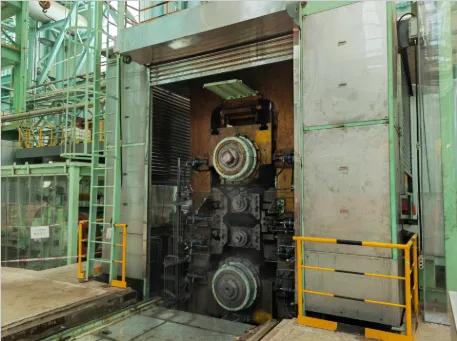
Application of Skin Pass Rolling in Automotive Steel Production
The automotive industry demands steel sheets with exceptional surface quality, precise mechanical properties, and consistent flatness to meet stringent manufacturing requirements. One of the most critical processes in achieving these characteristics is skin pass rolling, a light cold rolling operation applied after annealing. A 4 hi skin pass mill is typically used to impart the desired surface texture, improve flatness, and eliminate yield point elongation, which prevents stretcher strain marks during stamping.

The Fundamentals of Skin Pass Rolling in Automotive Steel Processing
1. Purpose and Mechanism of Skin Pass Rolling
Skin pass rolling, also known as temper rolling, is a precision cold rolling process applied to annealed steel strips to enhance their mechanical and surface properties. Unlike heavy cold reduction, which significantly alters thickness, skin pass rolling involves a minimal reduction (typically 0.5% to 3%) to achieve the following:
Elimination of Yield Point Elongation: Prevents Lüders bands (stretcher strains) that can form during deep drawing or stamping.
Improved Surface Texture: Imparts a controlled roughness for better paint adhesion and lubrication in forming processes.
Enhanced Flatness: Corrects minor shape defects remaining after annealing.
Work Hardening Adjustment: Fine-tunes mechanical properties for optimal formability.
2. Differences Between Cold and Hot Skin Pass Mills
While most skin pass rolling is performed at room temperature, a hot skin pass mill is sometimes used for specific automotive steel grades, particularly those requiring enhanced ductility or special surface finishes. The key differences include:
Cold Skin Pass Mill: Operates at ambient temperature, providing precise control over surface finish and mechanical properties.
Hot Skin Pass Mill: Processes steel at slightly elevated temperatures (below recrystallization), reducing flow stress and allowing for better shape correction in high-strength steels.
A 4 hi skin pass mill configuration (with two work rolls and two backup rolls) is commonly used due to its ability to apply uniform pressure across the strip width, ensuring consistent surface treatment.
Critical Applications of Skin Pass Rolling in Automotive Steel
1. Surface Quality Enhancement for Exposed Body Panels
Automotive exterior panels, such as doors, hoods, and fenders, require an exceptionally smooth and uniform surface to ensure flawless paint application. Skin pass rolling refines the strip surface by:
Reducing Surface Defects: Removes minor imperfections from prior processing.
Controlling Roughness: Adjusts peak count (Rpc) and peak-to-valley height (Rz) to optimize paint adhesion and gloss.
Preventing Orange Peel Effect: Ensures uniform deformation during stamping.
2. Improving Formability for Deep-Drawn Components
Structural automotive parts, such as chassis components and fuel tanks, undergo severe forming operations. Skin pass rolling enhances their formability by:
Suppressing Yield Point Elongation: Prevents strain localization that leads to surface defects.
Adjusting Hardness: Provides a slight work-hardening effect to improve strength without sacrificing ductility.
Enhancing Lubricant Retention: The controlled surface texture improves the effectiveness of forming lubricants.
3. Dimensional Stability for High-Strength Steel Grades
Advanced high-strength steels (AHSS) and ultra-high-strength steels (UHSS) are increasingly used in lightweight automotive designs. However, their high yield strength makes them prone to shape defects. A 4 hi skin pass mill ensures:
Residual Stress Relief: Minimizes coil set and edge waves.
Uniform Mechanical Properties: Balances strength and elongation across the strip length.
Springback Reduction: Improves dimensional accuracy in stamped parts.
Integration of Automatic Packaging Systems in Skin Pass Lines
After skin pass rolling, steel coils must be carefully handled to preserve surface quality before shipment to automotive manufacturers. Modern automatic packaging systems play a crucial role by:
1. Ensuring Scratch-Free Coil Handling
Robotic Wrapping Systems: Apply protective films without manual intervention.
Non-Contact Coil Transfer: Uses magnetic or vacuum lifters to avoid surface damage.
2. Quality Assurance and Traceability
Laser Marking: Engraves coil identification for tracking through the supply chain.
Automated Inspection Cameras: Detect surface defects before packaging.
3. Optimized Logistics for Just-in-Time Delivery
Automated Weighing and Labeling: Ensures compliance with automotive industry standards.
Palletizing Robots: Prepare coils for efficient transportation.
Future Trends in Skin Pass Rolling for Automotive Steel
1. Smart Skin Pass Mills with AI-Based Process Control
Adaptive Roll Force Adjustment: Uses real-time data to optimize rolling parameters.
Predictive Surface Quality Monitoring: AI algorithms detect potential defects before they occur.
2. Eco-Friendly Skin Pass Technologies
Dry Skin Pass Rolling: Reduces lubricant usage while maintaining surface quality.
Energy-Efficient Mill Designs: Lower power consumption in 4 hi skin pass mills.
3. Advanced Coating-Skin Pass Hybrid Lines
In-Line Surface Treatment: Combines skin pass with pre-treatment for galvanized and coated steels.
Laser-Textured Rolls: Customize surface patterns for specific automotive applications.
Skin pass rolling is an indispensable process in automotive steel production, ensuring superior surface quality, formability, and dimensional stability. The use of a 4 hi skin pass mill guarantees precise control over mechanical properties, while a hot skin pass mill offers unique advantages for high-strength steel grades. Furthermore, the integration of automatic packaging systems enhances efficiency and protects coil integrity throughout the supply chain.
As automotive manufacturers demand higher-performance steels with stricter quality requirements, advancements in skin pass rolling technology—including AI-driven process optimization and sustainable mill designs—will continue to play a pivotal role in meeting these challenges. By refining this critical process, steel producers can deliver materials that meet the exacting standards of modern vehicle manufacturing.
-
Indian Clients Visit YWLX to Inspect Skin-pass MillNewsJun.22,2025
-
Typical Products from Reversing Cold Rolling ProcessNewsMay.26,2025
-
Surface Finish Improvement through Skin Pass RollingNewsMay.26,2025
-
Integration of AGC Systems in Modern Cold Rolling MillsNewsMay.26,2025
-
Cold Rolling in the Context of High-Strength Steel DemandNewsMay.26,2025
-
AGC in Hot Rolling Mills: Challenges and SolutionsNewsMay.26,2025
-
Why Reversing Cold Rolling Mills Are Ideal for Specialty MetalsNewsMay.13,2025










